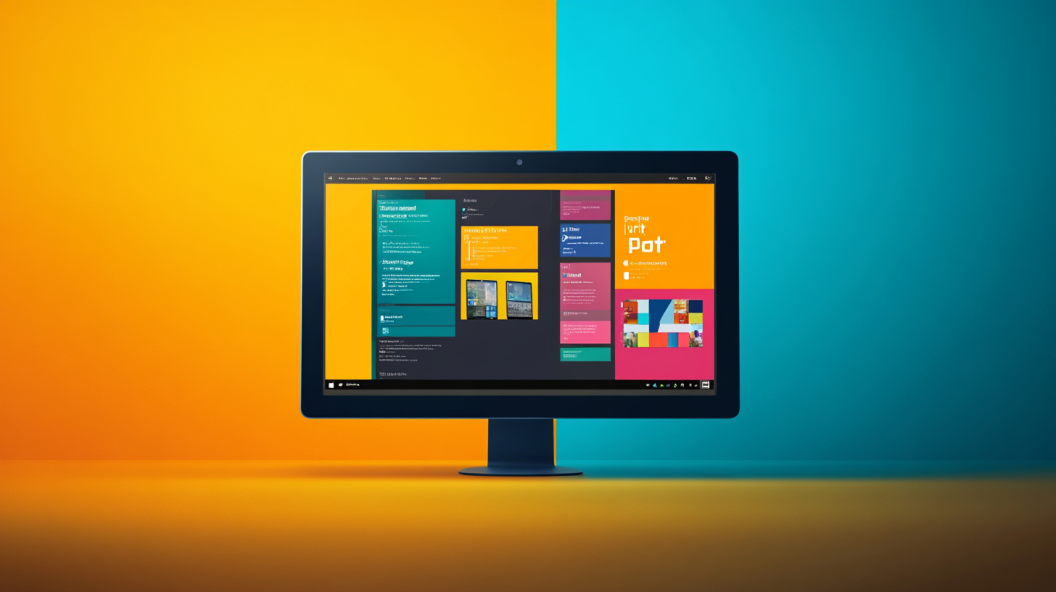How to Create Your First Application Using Microsoft Power Apps

Microsoft Power Apps lets you create your first application with ease. This platform empowers you to build custom applications tailored to your needs. You don't need to be a coding expert to get started. Custom apps can transform how you manage tasks, streamline processes, and solve unique challenges. Imagine having an app that fits your exact requirements. It's not just about building an app; it's about creating solutions that work for you. Dive in and start creating today. The possibilities are endless, and the journey is exciting!
Setting Up Your Power Apps Environment
Creating a Microsoft Account
To get started with Power Apps, you need a Microsoft account. If you don't have one, creating it is simple.
Signing Up for Power Apps
Visit the Power Apps Website: Head over to the Power Apps homepage.
Sign Up: Click on the sign-up button. Follow the prompts to create your account.
Verify Your Email: Check your inbox for a verification email. Click the link to confirm.
Once you're signed up, you're ready to explore the world of app creation.
Navigating the Power Apps Interface
The interface might seem overwhelming at first, but it's designed to be user-friendly.
Home Page: Here, you can start new projects or access existing ones.
Menu Options: Explore options like creating apps, connecting data, and accessing tutorials.
Help Resources: Use links to documentation and training courses to guide you.
Understanding the Power Apps Dashboard
The dashboard is your command center. It offers tools and features to build and manage your apps.
Key Features and Tools
App Templates: Start with pre-built templates to save time.
Data Connections: Easily connect to data sources like SharePoint or Excel.
Customization Options: Tailor your app's appearance and functionality.
Customizing Your Workspace
Make the workspace your own:
Layout Adjustments: Arrange tools and panels to suit your workflow.
Theme Selection: Choose themes that match your style.
Personalized Settings: Adjust settings for a more efficient experience.
By setting up your environment, you're laying the foundation for successful app development. Dive in and explore the possibilities with Power Apps!
Planning Your First Application
Defining the Purpose and Scope
Creating an app begins with understanding its purpose. You need to define what your app will do and who will use it. This step sets the foundation for everything that follows.
Identifying User Needs
Start by identifying the needs of your users. Ask yourself questions like, "What problems does my app solve?" or "How will it improve the user's experience?" Consider conducting surveys or interviews to gather insights directly from potential users. This approach ensures that your app addresses real-world challenges and meets user expectations.
Setting Goals and Objectives
Once you understand user needs, set clear goals and objectives for your app. What do you want to achieve with this application? Establish measurable outcomes to track your progress. For example, if your app aims to streamline a process, define how much time it should save users. Clear objectives guide your development process and help you stay focused.
Designing the User Interface
Designing the user interface (UI) is where creativity meets functionality. A well-designed UI enhances user experience and makes your app intuitive and easy to navigate.
Choosing Layouts and Themes
Select layouts and themes that align with your app's purpose and audience. Power Apps offers various templates to get you started. Choose a layout that organizes information logically and a theme that reflects your brand or style. Remember, simplicity often leads to better usability.
Incorporating User Feedback
Incorporate feedback from users throughout the design process. Share wireframes or prototypes with a small group of users and ask for their opinions. This feedback helps you refine the UI and ensure it meets user expectations. User-centered design principles emphasize the importance of accessibility and inclusivity, so consider feedback from users with diverse needs.
By carefully planning your app's purpose, scope, and design, you lay the groundwork for a successful application. Keep your users at the center of your planning process, and you'll create an app that truly resonates with them.
Create Your First Application: Building the Application

Now that you've set up your environment and planned your app, it's time to dive into building it. This section will guide you through adding data sources and creating screens and forms, essential steps in bringing your app to life.
Adding Data Sources
Data is the backbone of any application. PowerApps offers robust capabilities for integrating various data sources, allowing you to create comprehensive solutions tailored to your needs.
Connecting to SharePoint
Access the Data Tab: In your PowerApps interface, navigate to the data tab.
Select SharePoint: Choose SharePoint from the list of available connectors.
Enter Site URL: Input the URL of your SharePoint site.
Choose Lists: Select the lists you want to connect to your app.
Connecting to SharePoint allows you to leverage existing data, making your app more dynamic and functional.
Integrating with Excel and Other Services
Choose Excel Connector: From the data tab, select the Excel connector.
Upload or Link File: Either upload an Excel file or link to one stored in OneDrive.
Select Tables: Pick the tables you need for your app.
PowerApps also supports integration with other services like SQL Server, Dynamics 365, and Google Sheets. This flexibility ensures you can pull data from multiple sources, enhancing your app's capabilities.
Creating Screens and Forms
With your data sources connected, the next step is to design the user interface. Screens and forms are crucial for user interaction, so focus on creating a seamless experience.
Designing Input Forms
Add a New Screen: Click on the "New Screen" button in the interface.
Select Form Type: Choose the type of form you need, such as an edit or display form.
Drag and Drop Fields: Use the drag-and-drop feature to add fields from your data source to the form.
Designing input forms involves arranging fields logically to ensure users can easily input and retrieve data.
Setting Up Navigation
Create Navigation Buttons: Add buttons to your screens for navigation.
Set Button Actions: Define actions for each button, like navigating to another screen or submitting a form.
Test Navigation Flow: Run your app to test the navigation flow and make adjustments as needed.
Effective navigation enhances user experience by making it easy to move between different parts of your app.
By following these steps, you can successfully create your first application using PowerApps. Remember, the key is to integrate data effectively and design user-friendly interfaces. With practice, you'll become proficient in building apps that meet your specific needs.
Customizing App Functionality
Using Power Apps Formulas
Power Apps formulas are like the secret sauce that makes your app dynamic and interactive. They allow you to manipulate data, perform calculations, and create complex logic without writing traditional code. Think of them as Excel formulas on steroids!
Basic Formula Syntax
Getting the hang of formula syntax is crucial. In Power Apps, formulas start with an equal sign (=) and can reference controls, tables, and other elements in your app. For instance, if you want to display a message when a button is clicked, you might use a formula like If(Button1.Pressed, "Hello, World!"). This simple formula checks if the button is pressed and then displays a message.
Common Functions and Their Uses
Power Apps offers a plethora of functions to enhance your app's functionality. Here are a few you might find handy:
Text Functions: Use
Text()to format numbers or dates as strings.Math Functions:
Sum(),Average(), andRound()help perform calculations.Logical Functions:
If(),And(), andOr()let you create conditional logic.
These functions empower you to build apps that respond intelligently to user inputs and data changes.
Implementing Conditional Logic
Conditional logic is the backbone of any interactive application. It allows your app to make decisions based on user actions or data conditions. With Power Apps, implementing this logic is straightforward.
Setting Up If Statements
The If() function is your go-to for creating conditional statements. It evaluates a condition and returns different results based on whether the condition is true or false. For example, If(UserInput > 10, "High", "Low") checks if the user input is greater than 10 and returns "High" if true, otherwise "Low". This function is perfect for scenarios where you need to display different content based on user interactions.
Using Switch Functions
When you have multiple conditions to evaluate, the Switch() function comes in handy. It works like a series of If() statements but is more efficient and easier to read. For instance, Switch(UserChoice, "A", "Option A", "B", "Option B", "C", "Option C") evaluates the user's choice and returns the corresponding option. This function is ideal for dropdowns or scenarios with multiple possible outcomes.
By mastering formulas and conditional logic, you can transform your app from a static tool into a dynamic, responsive solution. Dive into these features, experiment, and watch your app come to life with Power Apps!
Testing Your Application

Testing your app is a crucial step in ensuring it works smoothly and meets user expectations. Let's dive into how you can effectively test your application.
Running Simulations
Running simulations helps you catch bugs and issues before your app goes live.
Identifying Bugs and Issues
Test Each Feature: Go through every feature of your app. Click buttons, fill forms, and navigate screens.
Look for Errors: Pay attention to any unexpected behavior or error messages.
Document Problems: Keep a list of any issues you find. This will help you track what needs fixing.
Gathering User Feedback
Share with Test Users: Let a small group of users try your app.
Ask for Opinions: Encourage them to share their thoughts on usability and functionality.
Collect Insights: Use surveys or interviews to gather detailed feedback.
Iterating Based on Feedback
Once you've gathered feedback, it's time to make improvements.
Making Necessary Adjustments
Prioritize Fixes: Focus on the most critical issues first.
Implement Changes: Adjust your app based on the feedback and identified bugs.
Enhance Features: Consider adding new features that users suggested.
Re-testing for Quality Assurance
Run Tests Again: After making changes, test your app thoroughly.
Ensure Stability: Check that all features work as intended without new issues.
Seek Final Feedback: Have users test the app again to confirm improvements.
By following these steps, you ensure your app is ready for deployment. Testing not only improves quality but also enhances user satisfaction. Keep refining your app, and you'll create a robust solution that meets your users' needs.
Publishing and Sharing Your App
Preparing for Deployment
Getting your app ready for deployment is an exciting step. You’ve built something valuable, and now it’s time to share it with the world.
Finalizing App Settings
Before you publish, make sure everything is set up correctly:
Review App Details: Double-check the app name, description, and icon. These elements help users identify and understand your app.
Test Functionality: Ensure all features work as intended. Run through each part of your app to confirm everything is smooth.
Optimize Performance: Look for ways to improve speed and efficiency. A fast app enhances user satisfaction.
Ensuring Data Security
Data security is crucial. Protecting user information builds trust and compliance with regulations.
Set Up Authentication: Use Microsoft’s security features to control who can access your app.
Encrypt Data: Ensure data is encrypted both in transit and at rest. This step keeps sensitive information safe.
Regular Updates: Plan for regular updates to address any security vulnerabilities.
Sharing with Users
Once your app is ready, it’s time to share it with your audience.
Setting Permissions
Control who can access your app by setting permissions:
Define User Roles: Decide who can view, edit, or manage the app. Assign roles based on user needs.
Use Groups: Leverage existing groups in your organization to streamline permission settings.
Monitor Access: Regularly review who has access to ensure it aligns with your security policies.
Distributing via Microsoft Teams
Microsoft Teams offers a seamless way to distribute your app:
Integrate with Teams: Add your app directly to Teams for easy access.
Create Channels: Use channels to organize discussions and support related to your app.
Engage Users: Encourage feedback and collaboration through Teams, enhancing user engagement.
By following these steps, you’ll successfully publish and share your app. Power Apps makes it easy to reach your audience and provide them with valuable tools. Enjoy the process and watch your app make a difference!
Key Takeaways and Benefits
Advantages of Using Power Apps
Rapid Development
You can build apps quickly with Power Apps. The platform offers tools that simplify the development process. Drag-and-drop features let you create without coding. This approach saves time and gets your app up and running fast.
Cost-Effectiveness
Power Apps provides a budget-friendly solution. You don't need expensive software or developers. The platform's subscription model keeps costs predictable. You can create powerful apps without breaking the bank.
Encouragement to Explore Further
Continuous Learning Resources
Keep learning with Power Apps' resources. Tutorials and guides help you master new skills. Explore Microsoft’s learning paths for in-depth knowledge. These resources ensure you stay updated and improve your app-building abilities.
Joining the Power Apps Community
Join the Power Apps community to connect with others. Engage in forums and discussions. Share your experiences and learn from peers. The community offers support and inspiration, helping you grow as a developer.
Frequently Asked Questions
Common Concerns
When you're starting with Power Apps, you might have some questions. Let's address a few common concerns to help you on your journey.
Troubleshooting Tips
Encountering issues is normal when building apps. Here are some tips to troubleshoot effectively:
Check Connections: Ensure all data sources are connected properly. A broken link can cause errors.
Review Formulas: Double-check your formulas for typos or logical errors. A small mistake can lead to unexpected results.
Test in Stages: Test your app in small sections. This approach helps you identify where problems occur.
Use Debugging Tools: Power Apps offers debugging tools. Use them to trace errors and understand their causes.
If you follow these tips, you'll resolve most issues quickly. Remember, practice makes perfect!
Best Practices for Beginners
Starting with Power Apps can feel overwhelming. Here are some best practices to guide you:
Start Simple: Begin with a basic app. Focus on mastering the fundamentals before tackling complex projects.
Plan Thoroughly: Outline your app's purpose and features. A clear plan saves time and reduces errors.
Leverage Templates: Use Power Apps templates. They provide a solid foundation and inspire new ideas.
Seek Feedback: Share your app with others. Constructive feedback helps you improve and learn.
Stay Updated: Follow Power Apps updates and community discussions. Staying informed keeps your skills sharp.
By adopting these practices, you'll build confidence and create successful apps. Enjoy the process and keep exploring!
Creating your first app with Microsoft Power Apps is an exciting journey. You've learned to set up your environment, plan, build, and customize your app. This process empowers you to solve real-world problems creatively. Keep exploring Power Apps to enhance your skills and discover new possibilities.
"The importance of problem definition and creative use of features cannot be overstated." - Intellify's Learning Management System
Share your experiences and feedback with the Power Apps community. Your insights can inspire others and foster collaboration. Dive deeper into this dynamic platform and watch your ideas come to life!
See Also
Revolutionize Business Operations with Microsoft Power Apps
Streamline Processes with Microsoft Power Automate
Publishing Your App on Azure Marketplace Made Easy
Discovering the Path of a Microsoft Power Platform Developer
